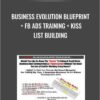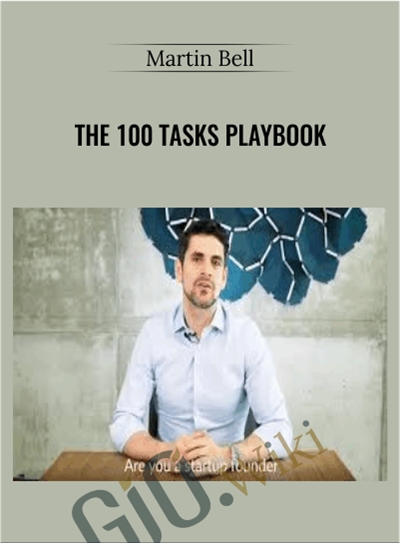$497.00 Original price was: $497.00.$99.00Current price is: $99.00.
In my previous company, which pioneered Berlin’s thriving startup ecosystem, I was chief architect of a system that allowed us to launch companies in 100 days max. In one year, we led over 20 companies through this proven system, once in only 28 days.
 Purchase this course you will earn 99 Points worth of $9.90
Purchase this course you will earn 99 Points worth of $9.901) Hi Martin, would you share with us how you came up with the 100 Task Startup playbook?
The “100 Task Startup” playbook is the product of my vast experience in building — or overseeing the building — of great companies.
In my previous company, which pioneered Berlin’s thriving startup ecosystem, I was chief architect of a system that allowed us to launch companies in 100 days max. In one year, we led over 20 companies through this proven system, once in only 28 days.
Over the past years, I’ve consulted over 30 private and public sector entities. Along this journey, I wanted to answer the question: What makes a startup a success? Specifically, I wanted to discern
- which tasks are skipped by ventures that fail and,
- which tasks are essential to those that succeed.
Admittedly, I got a little obsessed and excited in the process. Yet despite the complexity, I distilled the truly necessary steps into a comprehensive yet reasonably-sized playbook.
Those steps can be distributed into three stages:
- Setup,
- Launch,
- Scale.
Each of the 3 stages has 5 elements. They include, among others:
- Plan mission
- Develop MVP, and
- Optimize Functions.
Then, diving into a level of detail that is actionable, I essentially identified 100 tasks necessary to build a successful startup!
I know that prescribing 100 tasks can sound overwhelming, but I wanted the Playbook to dive into the nuts-and-bolts of building companies. By breaking it into 100 concrete tasks, the Playbook is not stuck hovering at a stratospheric high level. Most frameworks propose only 3, 5, or 7 generic steps.
In fact, the Playbook provides both the high-level and the nitty-gritty. Importantly, it offers the bird’s-eye view with its 3 broad stages, while simultaneously offering the option to deep-dive into 100 specific tasks, which are categorized not only into one of 3 stages but also into
- sub-stages,
- types of task,
- functional areas, and
- timing.
2) Who is the target for this tool? You write “the playbook presents the granular steps a major organization needs to setup a systematic company-building structure”, is the primary target large corporations who want to build a launchpad/incubator for ventures? Is the playbook only for entrepreneurs, or can it be used by intrapreneurs?
Primarily, the target of the Playbook is any major organization. More specifically, it targets any major organization that wants to setup a systematic company-building structure — a “launchpad” or an incubator — that is capable of launching and scaling multiple ventures. As Clayton Christensen’s classic The Innovator’s Dilemma argues, radical innovation — the type that will one day save the corporation — needs to happen outside of the parent in a separate environment due to people, processes, and P&Ls that stand in natural conflict with one another. ”. How to establish a “launchpad” that is capable of launching and scaling multiple ventures is explained in stage 1, Setup.
It’s important to note that the Playbook differentiates itself from the plethora of startup literature out there because it’s from the viewpoint of a major organization, not from a stand-alone startup. While on the poster the Playbook calls its target “corporates”, the Playbook is actually relevant to any public or private sector entities — governments, universities, NGOs, investors, and of course corporates — who want to transform their own innovative ideas into successful companies.
In addition, a huge side benefit is that the vast majority of the 100 Tasks are relevant for any stand-alone startup.
Thus, the Playbook is so versatile that it can be utilized from the viewpoints of various types of organizations.
3) Is it better suited for some specific industries, BtoB vs BtoC, or e-commerce, online food delivery, marketplaces, fintech, and urban mobile on-demand?
The Playbook is industry-agnostic and proven for B2B or B2C organizations. How is that possible? It’s possible because I gathered all important steps to successfully build great companies fast. Then, I went through painstaking analysis in order to distill it into only the “least common denominator” steps that are relevant relevant for any organization.
More important than the Playbook’s vast applicability is that the Playbook embodies the fact that innovation success is all about the execution. In that respect, the 100 Tasks stand in stark contrast to the vast majority of the literature on entrepreneurship. Unlike such typical literature, the 100 Tasks focus not only on the ideation, but much more on so on the execution of that idea.
Political economist Joseph Schumpeter is the intellectual father of entrepreneurship and innovation. His definition of innovation is that “innovation is the commercial spread of ideas”. Therefore, while most people use the term “innovation” to mean “invention”, Schumpeter’s definition goes much further, underlining the fact that real innovation is about the successful execution of that initial idea.
To illustrate, Thomas Edison is not only the most prolific inventor of modern times, but he is more importantly one of the most prolific innovators. In his famous quote, he maintained that “innovation success is 1% idea and 99% execution”. Coming from Edison, that means a ton.
I agree with Schumpeter and Edison that the idea is the most important step, but that there are many many other steps as part of the execution that follow.
Thus, the 100 Tasks do focus on the ideation part in stage 1, the Setup stage. In that stage, several tried and true frameworks are cited in the 100 Tasks. Examples are the Three Horizons, Four Steps to the Epiphany (i.e. Customer Development), Design Thinking, Business Model Canvas, and of course Lean Startup.
However, the 100 Tasks, especially stages 2 and 3, focus on the execution of that idea, an area in which there is a dearth of literature. The Playbook fills that critical void to make sure entrepreneurs and intrapreneurs don’t inadvertently drive their idea off a cliff.
Get The 100 Tasks Playbook – Martin Bell , Only Price $99
4) Could you present the 3 main stages of the playbook?
The 3 stages — Setup, Launch, and Scale — are successive. That means, that one must complete one stage in order to move onto the next one. It’s analogous to a stage-gate® at the end of each stage.
Stage I: SETUP
In this crucial foundational stage, the launchpad infrastructure, capable of building multiple startups, is set up by the organization.
Meanwhile, the entire ideation journey is traveled:
- a long list of ideas is turned into a short list,
- from the short list one decides on one idea to validate, and
- once that idea is validated the startup is ready to move onto the next stage.
The setup stage groups its tasks into the following 5 sub-stages:
- Plan Mission
- Staff Launchpad
- Collect Ideas
- Validate Ideas
- Make Starter-Kits
Stage II: LAUNCH
In this stage, a validated idea is commercialized, or brought to market. The company’s various functions are systematically built in order to rapidly achieve go-live (i.e. first revenues). Functions are built to last, while focusing only on the must-haves that are launch-critical.
The launch stage groups its tasks into the following 5 sub-stages:
- Staff Temporarily
- Develop MVP
- Build Functions
- Set Up KPI Reports
- Go-Live
Stage III: SCALE
This stage is the one in which the live company’s functions are optimized, or set up for success, so that the company can grow sustainably. It is very much about leveraging data to find adjust the business model to find product-market find, and about implementing best practices.
At the end, the startup is ready to be independent, externally funded, best practices have been implemented, fully staffed, and it can stand on its own feet.
The setup stage groups its tasks into the following 5 sub-stages:
- Staff Permanently
- Learn From Data
- Optimize Functions
- Best Practices
- Independence
5) Innovation is about iteration: how do you instill iteration in the playbook checklist, and do you help the user to measure if a task is fulfilled completely, or only 20% or 50%?
I agree 100% that “innovation is about iteration”. While the Playbook is all about “getting sh*t done”, it’s iterative and agile at its core!
A task should eventually be fulfilled 100%. You should not leave the tasks “Define goals”, “Build supply chain”, or “Phase in OKR system” incomplete. I sincerely believe that either a task is 100% done or it’s not done. In the eyes of the market, if it’s done you succeed, if it’s 20% or 50% done you fail.
However, solutions should not be over-engineered. Staying with the percentages theme, I’m a strong advocate of the 80%/20% rule (Pareto principle), which posits that roughly 80% of the effects come from 20% of the causes, when it comes to building companies fast in an iterative way. Remember: it needs to be done, not perfect.
When looking at the 100 Tasks poster, note that the tasks run in parallel. It’s agile, not waterfall. That means that tasks do not need to be fulfilled 100% before moving on to the next one. What matters in the 100 Tasks is the sequence of the tasks. It purposely places tasks 1) with long lead or setup times and 2) on which many outcomes depend on EARLY. Many intrapreneurs or entrepreneurs fall prey to starting some tasks like these — “Kick off hiring roadmap”, “Incorporate legal entity”, “Set up a bank account”, “Specify MVP”, or “Institute sales funnel” — far too late.
The iterative, lean-startup nature of the 100 Tasks is clearly reflected in the Milestones section at the bottom of the 100 Tasks poster. More specifically, whenever there is a second arrow that points to a previous milestone, it means that if a certain milestone was not achieved in full one needs to go back. For example, if one does not achieve “Validated Venture”, one should dispose of that idea and pick the next best one on the “Short List”. Or: if the “Go Live” (i.e. launch) fails, then one should re-do its “Stress Test” in a more comprehensive manner.
Get The 100 Tasks Playbook – Martin Bell , Only Price $99
Tag: The 100 Tasks Playbook – Martin Bell Review. The 100 Tasks Playbook – Martin Bell download. The 100 Tasks Playbook – Martin Bell discount.
Only logged in customers who have purchased this product may leave a review.
Related products
Uncategorized
Managing Patient Emergencies: Critical Care Skills Every Nurse Must Know – Dr. Paul Langlois
= 85 Points
Uncategorized
= 85 Points
= 85 Points
Uncategorized
= 30 Points
= 72 Points
Uncategorized
Cognitive Rehabilitation Therapy: Practical Interventions and Personalized Planning – Jane Yakel
= 85 Points
Uncategorized
= 85 Points
= 84 Points





Reviews
There are no reviews yet.